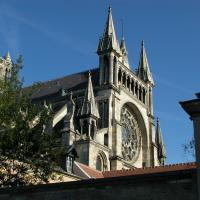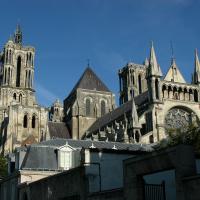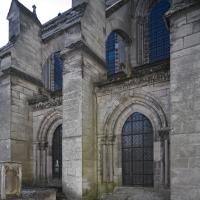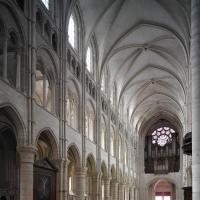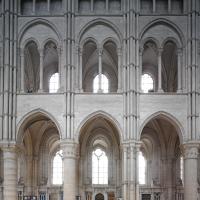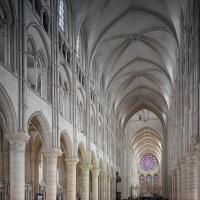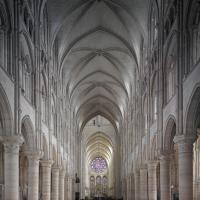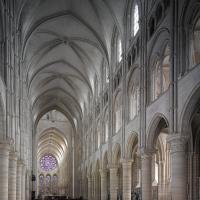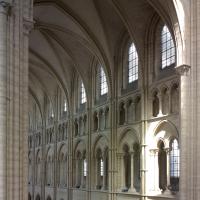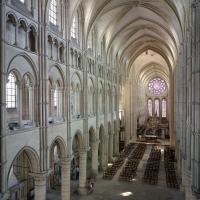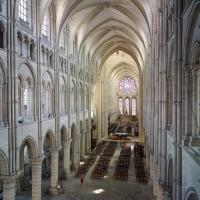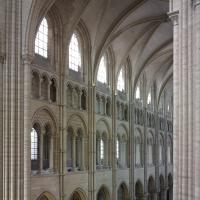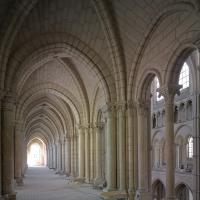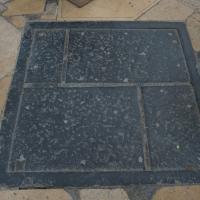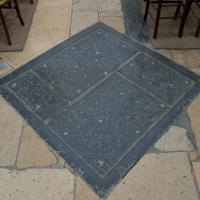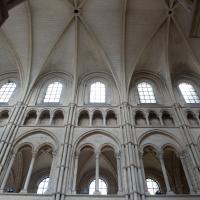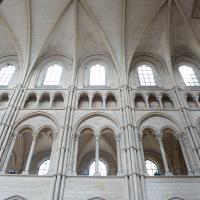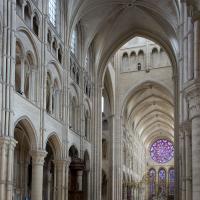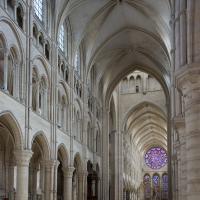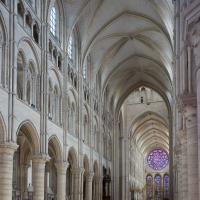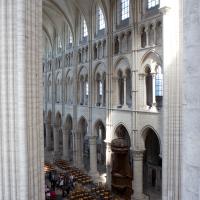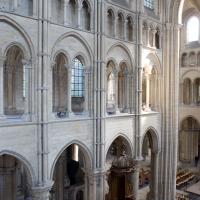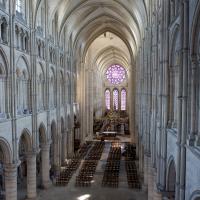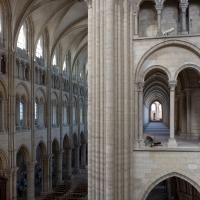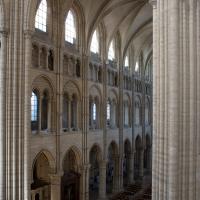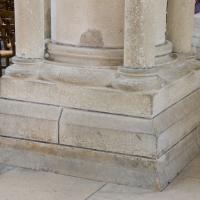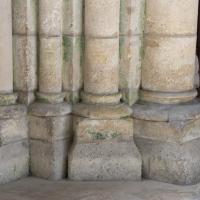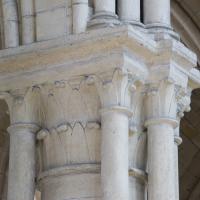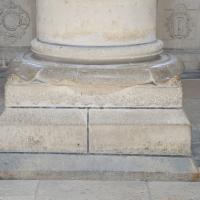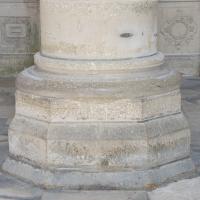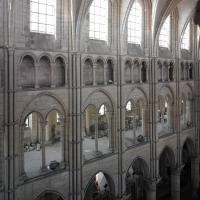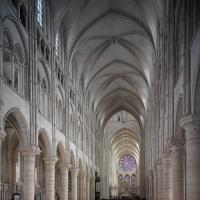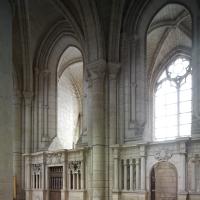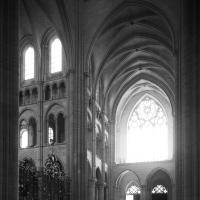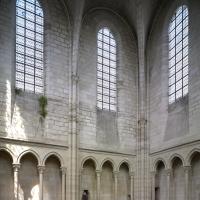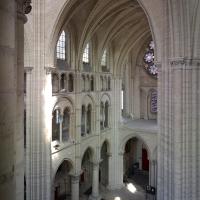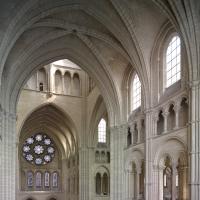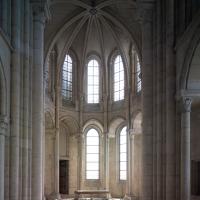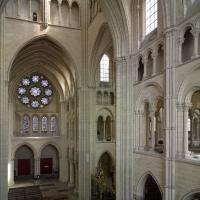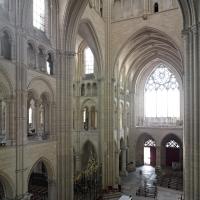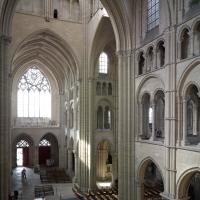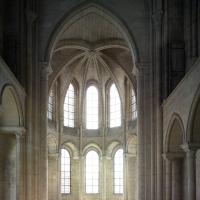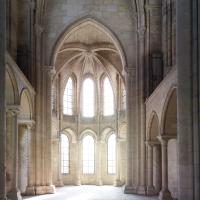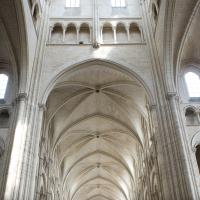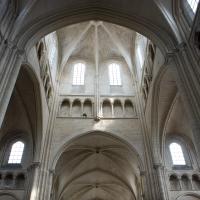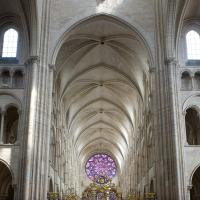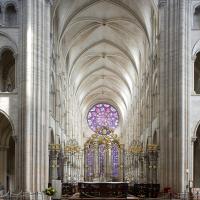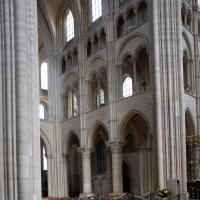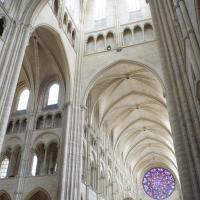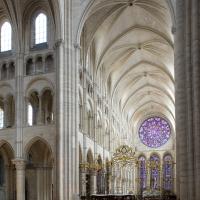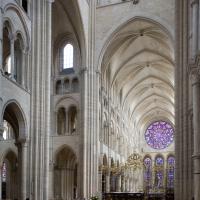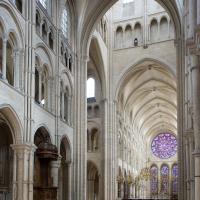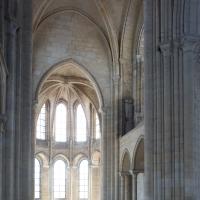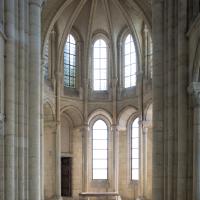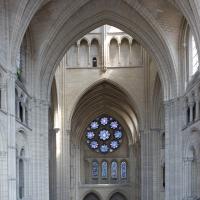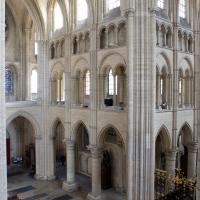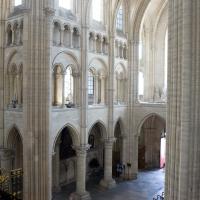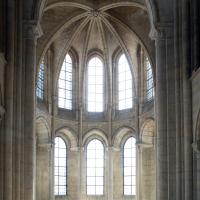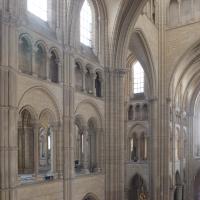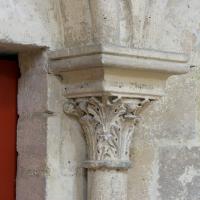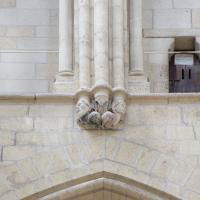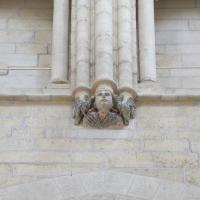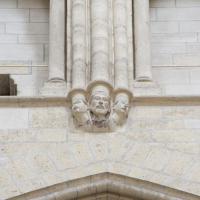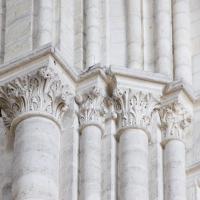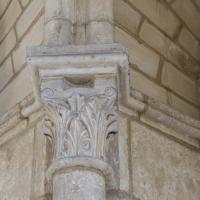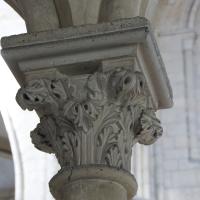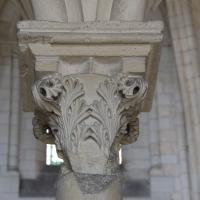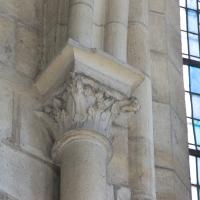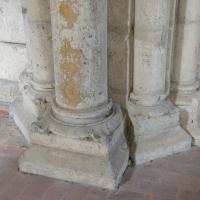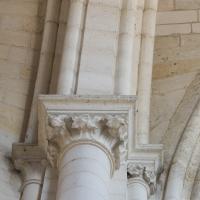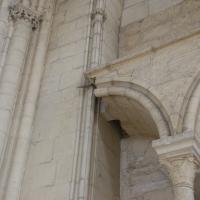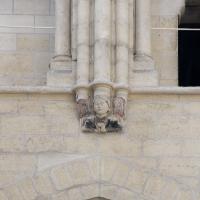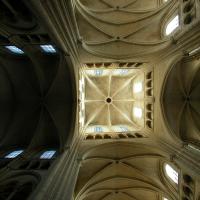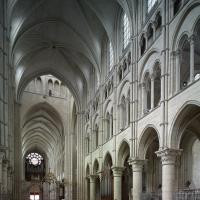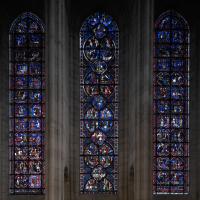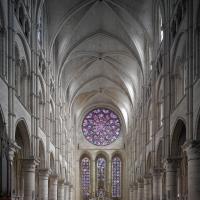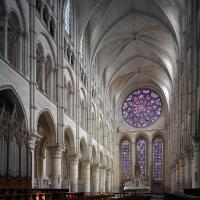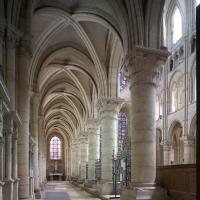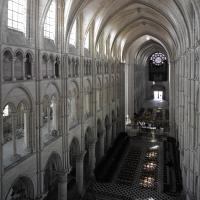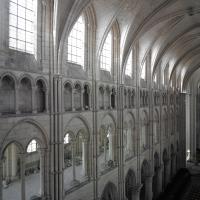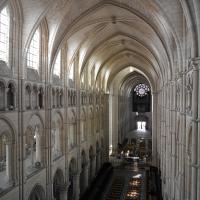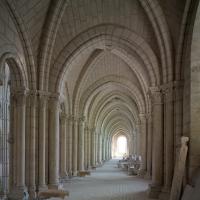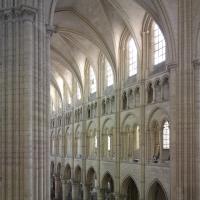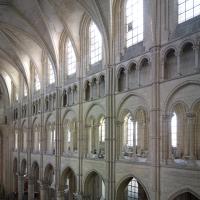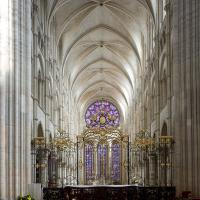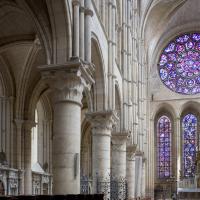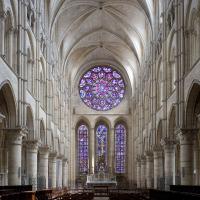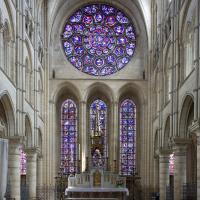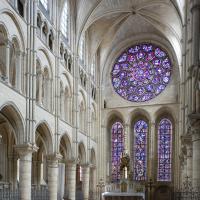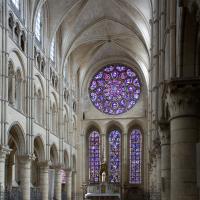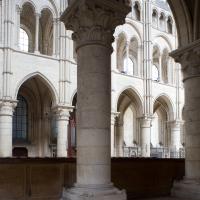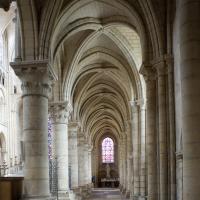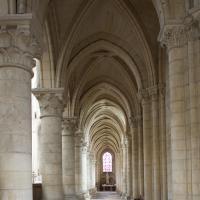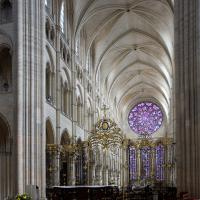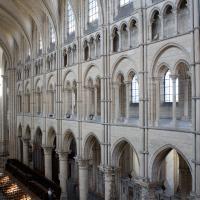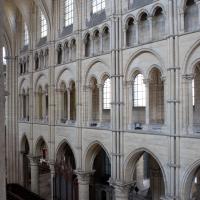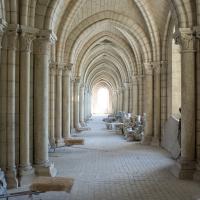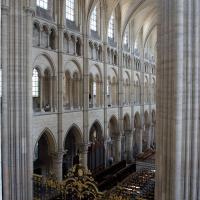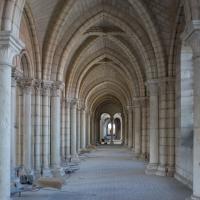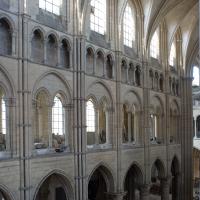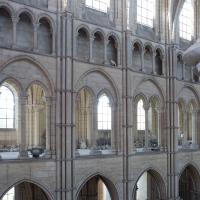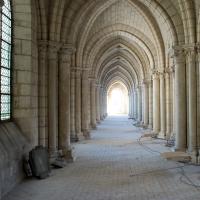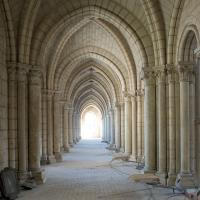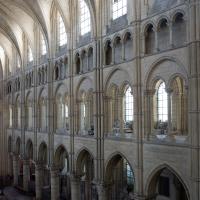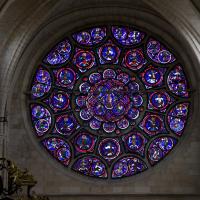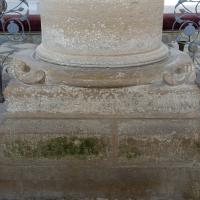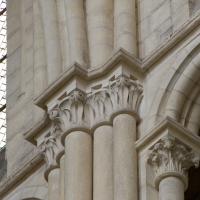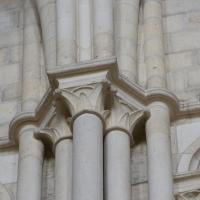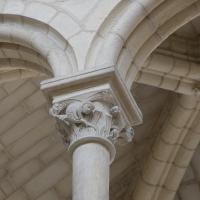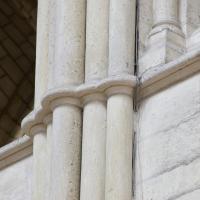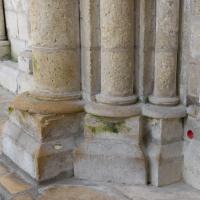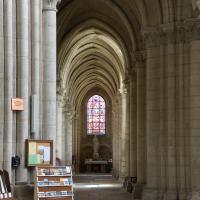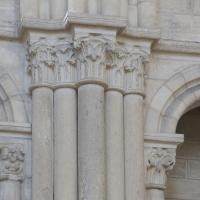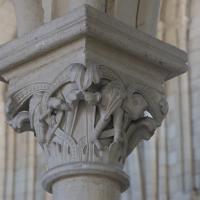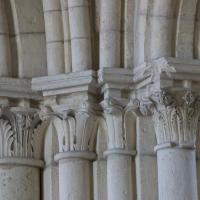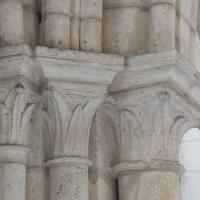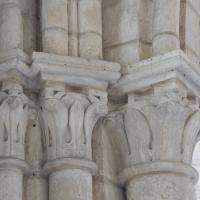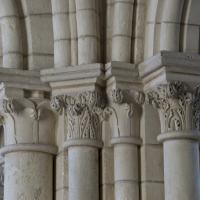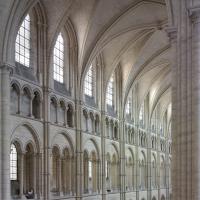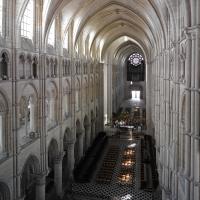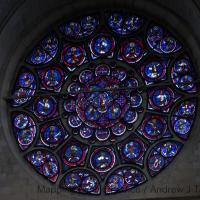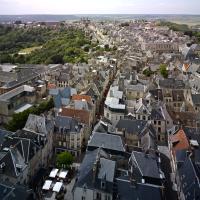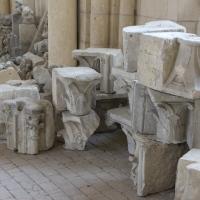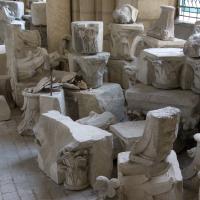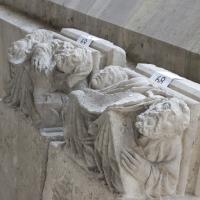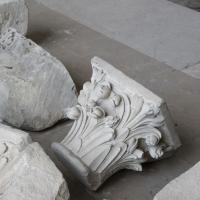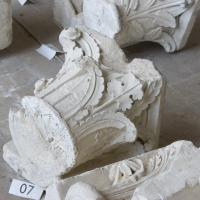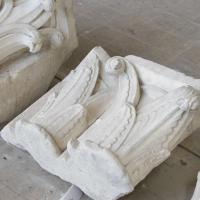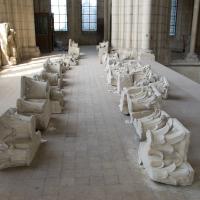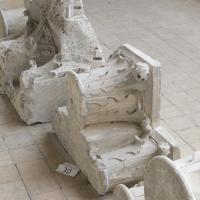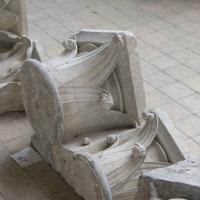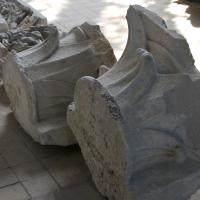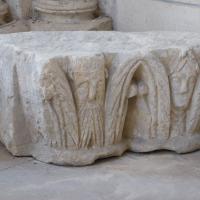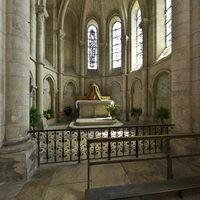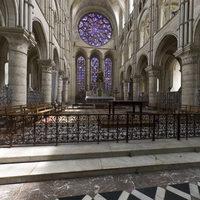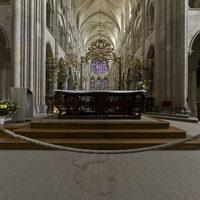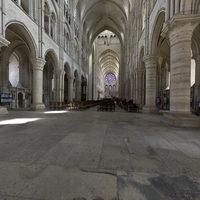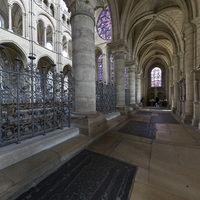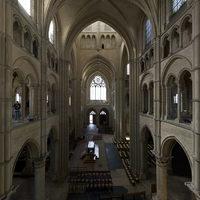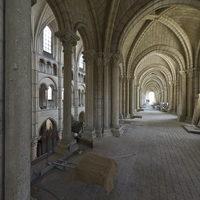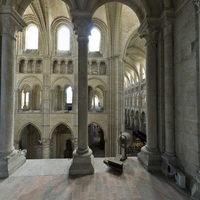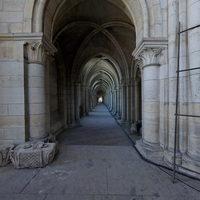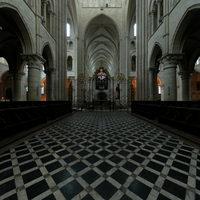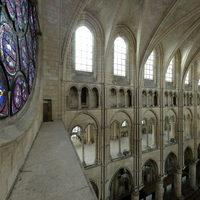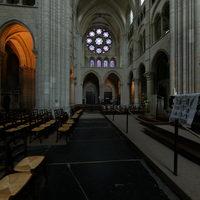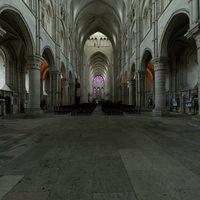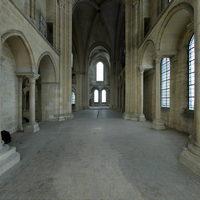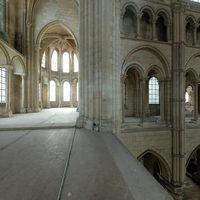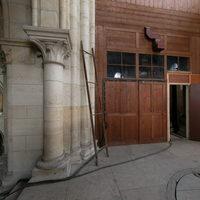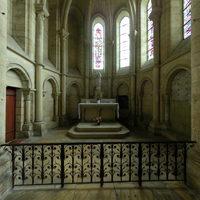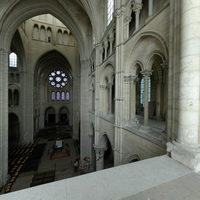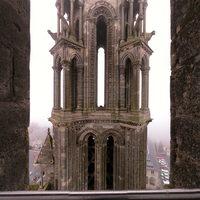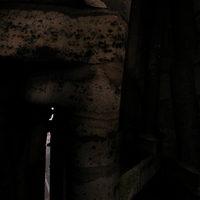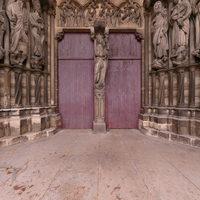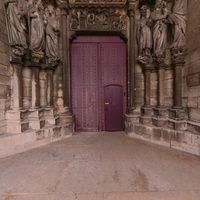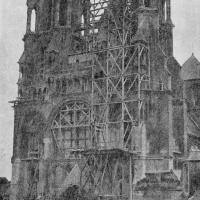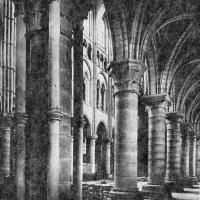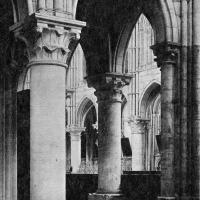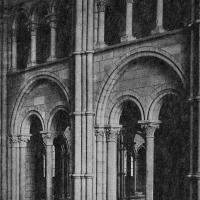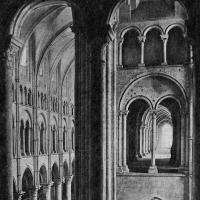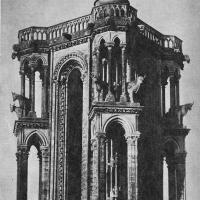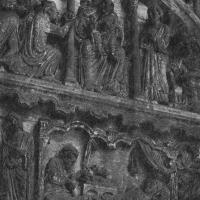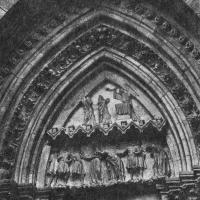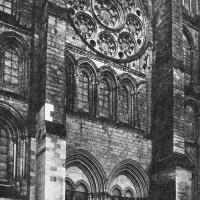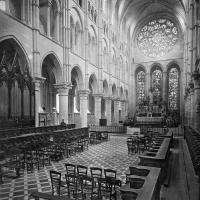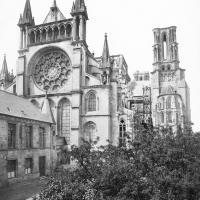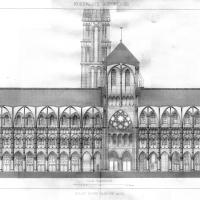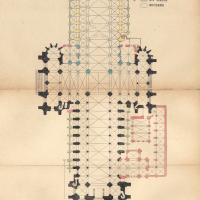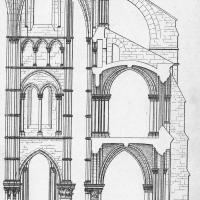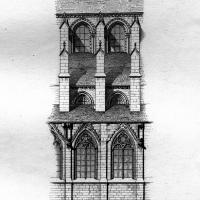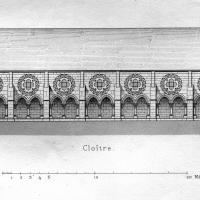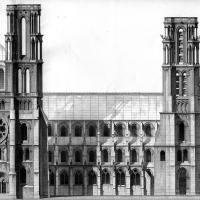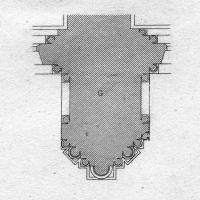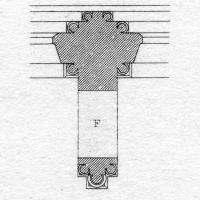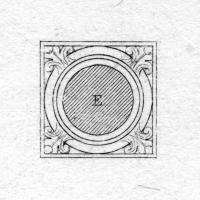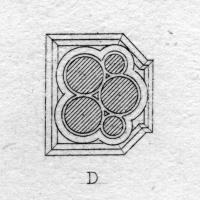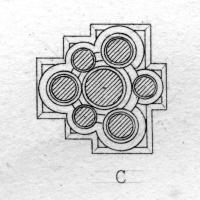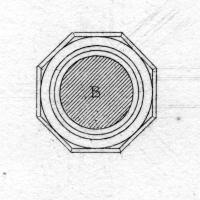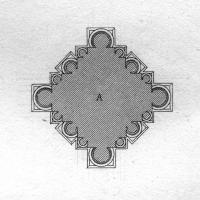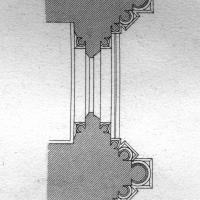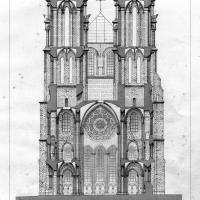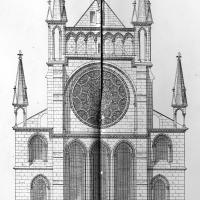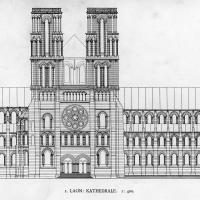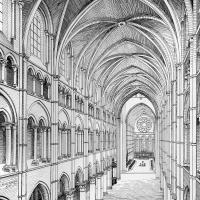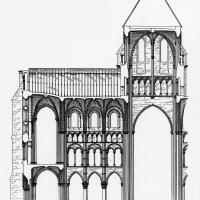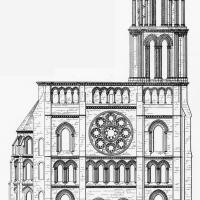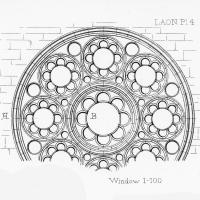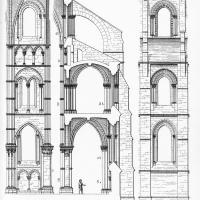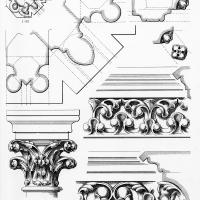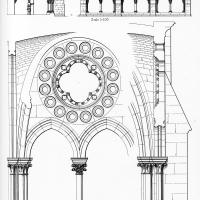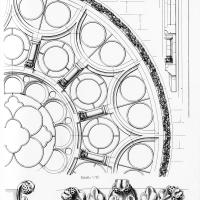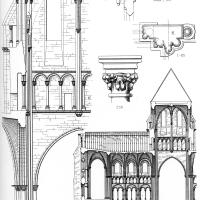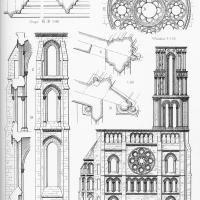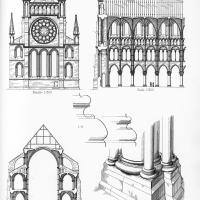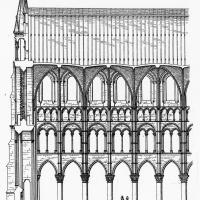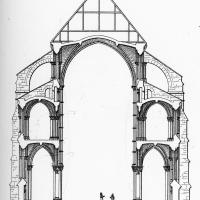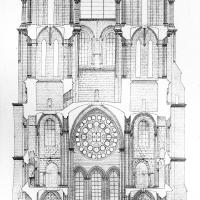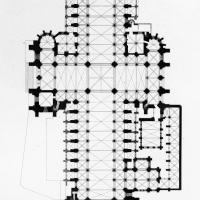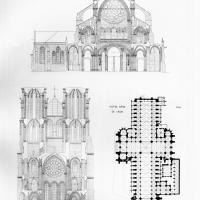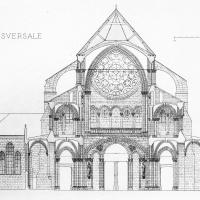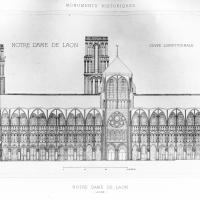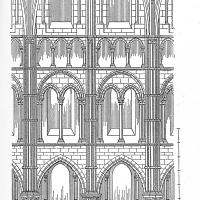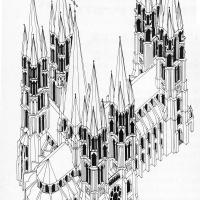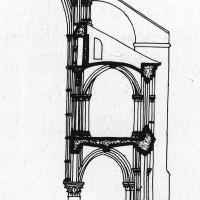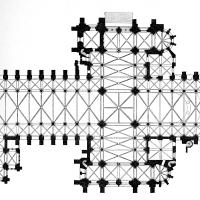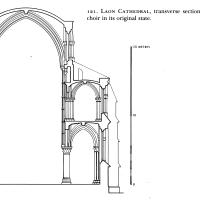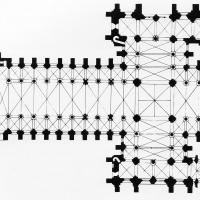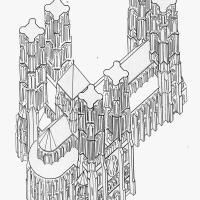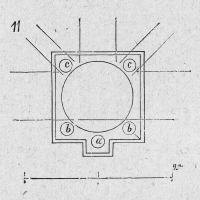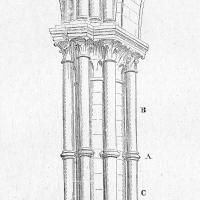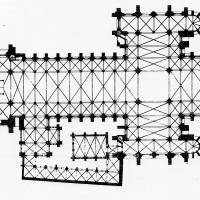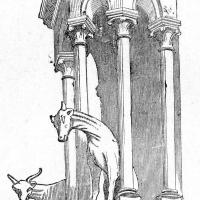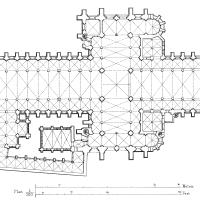Images
VR Tour
Notes
Date
Begun ca. 1150
Plan
A long basilica intersected by a deep transept terminated in the east by a chevet plat and terminated in the west by double towers. What is striking about the exterior is the cluster of towers originally intended to have nine towers of which four were built two in the western, four at the crossing one in the center. The articulation of the interior is remarkably regular. A four-story elevation throughout. Sexpartite vaulting covers the main vessel but the designers choose not to reflect an alternation in the supports which except for the eastern bays of the nave are made up of cylindrical columns.
Chronology
Begun in the 1150s under Bishop Gautier de Mortagne (1154-1171) in the east end, which was originally formed by a shallow (3-bay) chevet with rounded ambulatory. Chevet may have been complete by 1164, the date of the translation of the relics of Saint Béat. Work progressed from east to the west, reaching the west before 1200. Work then returned (circa 1200) to the east end, where an extended chevet plat was constructed, thought to have been complete by 1228. Dedication of the cathedral took place between 1236 and 1257. There are extensive amounts of masonry from the old choir used in the rebuilt portions of the cathedral. At the end of the 13th and into the early 14th century chapels were added between the culées of the nave.
Sculptural Program
Despite its intact appearance, the sculpture at Laon has been heavily restored, which led Paul Williamson, in his book on Gothic sculpture, to remark that "the portals at Laon tell us almost as much about the stylistic tendencies of the nineteenth-century restorer as the late twelfth-century workshop." This is especially true in the case of the column figures. Only two column figures remain that can be securely tied to the western frontispiece. These remnants, now in the municipal museum in Laon, were found in the tribunes of the cathedral. A corbel fragment also survives, which depicts a crouching figure in a tunic; this element was likely attached to another column figure on the western frontispiece. Based on these fragmentary remains, it seems that these column figures represented Old Testament prophets, which fits with the iconography of the tympana and lintels, and corresponds with contemporary sculptural programs elsewhere that featured prefigurations of Christ and prophets (cf. Chartres transept). Iliana Kasarska has proposed that the extant prophets were originally installed on the right embrasure of the center portal, although this remains conjectural.
The central portal depicts the Coronation of the Virgin, a motif first seen at Senlis in the 1160s, which was subsequently repeated elsewhere and remained common well into the thirteenth century and beyond. In the tympanum, we see the Coronation with flanking angels holding lamps and censers. Although the current pairing of the Dormition and Assumption of the Virgin on the lintel makes sense iconographically in the scheme of a Coronation portal, its former aspect was known, at least to some degree, by the nineteenth-century restorers, but there is no extant documentation that relates to the original program.
In the voussoirs that comprise the first archivolt, a series of angels turn toward the drama enacted in the tympanum. The next two archivolts are filled with a Tree of Jesse, its mandorla-like stems wrapping around the figures. Kasarska makes the astute observation, supported by other scholars, that virga (i.e. scion, from Isaiah 11) and virgo (virgin) were conflated in the Middle Ages, and thus the two were linked based on this misinterpretation. This most likely gave rise to -- or at least bolstered -- the sculptural trope that envisaged the Tree of Jesse as expressing the genealogy of the Virgin.
The column figures in the embrasures of the central portal are the product of the nineteenth-century restoration. The figure of Isaiah, for example, dates to 1846 and was based on the depiction of Isaiah in the central portal of the north arm of the transept at Chartres. Some fragments of column figures remain in the municipal museum in Laon; however, the provenance of these statues has been contested. In any event, a drawing from the latter part of the eighteenth century by Tavernier de Jonquières does attest to the presence of column-figures at Laon. Similarly fanciful is the modern trumeau figure. Kasarska has posited that the figure in the trumeau at Laon was, in fact, a Virgin, in line with the theme of the rest of the portal; however, no traces of this figure remain.
The north portal seems bound to the theme Incarnation. In the tympanum sit the enthroned Virgin and Child, with the Magi, an attending angel, and a seated figure, probably intended to represent Joseph, flanking the central figures. This is a kind of hybrid, merging a sedes sapientiae with an Adoration scene. A cast made before the restoration of this portal help guide our understanding of its original appearance. From left to right, the scenes depicted in the lintel are the Annunciation, the Nativity, and the Annunciation to the Shepherds. The innermost archivolt features angels, which are symmetrically rendered to either side of the tympanum (lowest voussoirs: censing; middle: bearing lamps; highest: crowns). A dove appears in the keystone of this archivolt. In the second archivolt, we see the Virtues and Vices (remarkably, the Virtues are seen fighting personifications, not demons). The third and fourth archivolts seem to provide prefigurations of Mary's virginity via Biblical narratives, although the specific scenes are somewhat opaque.
The Adoration of the Magi grouping solidifies the importance of the Virgin as Queen of Heaven (she receives gifts with the Christ child, whereas Joseph is relegated to the corner in this scene). The Annunciation follows numerous Romanesque prototypes. The Nativity relates to the south portal of the western frontispiece of Notre-Dame of Paris. The representation of the Magi fell out of use for the most part in the latter half of the twelfth century, so its appearance here is a "retour en arrière." At Laon, the Visitation is not depicted, separating this program from those at La-Charité-sur-Loire and Chartres, to which this portal at Laon is otherwise closely related. Virtues and Vices in the voussoirs anticipate Notre-Dame of Paris.
The theme of the south portal is the Last Judgment. The tympanum features Christ flanked by apostles, who carry keys, books, and keep their hands clasped in prayer, and angels, who hold Instruments of the Passion. The heads of these figures and the arms of Christ are part of the nineteenth-century restoration, but Sauerländer singled out the remainder of the tympanum for its early date, placing it as early as 1160 based on stylistic evidence. Resurrected bodies can be seen emerging from tombs to either side of Christ's feet. In the lintel below, Saint Michael oversees the separation of the elect from the damned. The inner two archivolts, which, like the tympanum, may date to the middle of the twelfth century, depict apostles, angels with trumpets, angels bearing souls, and Abraham with blessed souls in his bosom. The outer archivolts, which date to the same period as the majority of the western frontispiece (i.e. 1195-1205). These voussoirs feature martyrs, unidentified enthroned figures with nimbuses, angels, Wise and Foolish Virgins, and musicians.
The south portal is linked iconographically to the Last Judgment portal at Saint-Denis. The presence of martyrs in the archivolts from the end of the twelfth century are iconographic pioneers: until this point, martyrs were not part of Last Judgment ensembles (traditionally, this space was reserved for apostles and elders). This arrangement recurs in the cathedrals of Chartres, Paris, and Amiens.
The sculpture of the western frontispiece is not limited to the space of the three portals. The apex of each gable, for instance, is sculpted. In the north gable is a feminine figure wearing a long garment. The original sculpture is in two fragments, one in the depot of the cathedral, and the other in the municipal museum in Laon. The sculpture now in its place on the western frontispiece is a nineteenth-century restoration. The iconography is disputed, but it most likely represents the Virgin surrounded by two angels. The center gable is filled with an enthroned Virgin with flanking angels. The south gable features the archangels Gabriel, Michael, and Raphael. The lateral windows in the upper story, next to the rose window, also feature sculpted bands, with a Creation cycle to the north, and a personifications of philosophy and the liberal arts to the south of the rose. Kasarska interprets the western frontispiece as an ensemble, and thus the gables and upper windows don't necessarily correspond directly to the program below, but instead to the overall themes of the western frontispiece, particularly eschatology and the cult of the Virgin.
Sauerländer takes the cue of the transept portals at Chartres as the terminus ante quem for the portal sculpture on the western frontispiece at Laon, suggesting a date between 1190 and 1204; Williamson places the sculpture ca. 1195-1205. Portions of the tympanum and the two innermost archivolts of the south portal may date to the third quarter of the twelfth century.
Sauerländer has expressed the role of Laon as a touchstone for the ymagiers at Chartres and Reims. He has also pointed to manuscript and metalwork prototypes for the sculptural program at Laon (in particular, he has singled out the Ingeborg Psalter, now in the Musée Condé in Chantilly), although this type of appropriation is difficult to prove and tends to confirm that in this period there were similar modes of rendering figures across media.
Significance
This building is one step later than Notre-Dame of Paris b-1164 and also belongs to an "extended" family of buildings with four-story elevations, including Noyon b-1037, Saint-Germain-de-Fly b-1046, Tournai b-1201, Soissons pl-1008 south transept arm, Saint-Remi at Reims b-1043 as rebuilt, Notre-Dame-en-Vaux b-1016 as rebuilt and Cambrai pl-1043 which has been destroyed. It gives the appearance of a common language--a koiné. The common language would have you believe there is unity, but they belong to disparate places. Notre-Dame of Paris is in an urban environment, where the clergy were struggling to maintain power; Laon is the old, well-established Carolingian center, with eighty canons.
Location
Bibliography
Abou-El-Haj, B. F., "Artistic integration inside the cathedral precinct: social consensus outside?" Artistic Integration in Gothic Buildings, Ed. Virginia Chieffo Raguin, Kathryn Brush, and Peter Draper, Toronto, 1995, pp 214-235
Adenauer, H., Die Kathedrale von Laon. Studien su ihrer Geschichte und ihrer stilistischen Fundierung in Rahmen der französischen Architektur, Düsseldorf, 1934
Berry, Maurice, "La cathédrale de Laon et son environnement," Monuments historiques de la France, 4 (1975) 8-15.
Boerner, B., "Lasterdarstellungen in der mittelalterlichen Monumentalkunst Frankreichs," Laster im Mittelalter: Vices in the Middle Ages, Ed. Christoph Füeler and Martin Rohde, Berlin, 2009, pp 65-103
Bouxin, A., La cathédrale Notre-Dame de Laon. Histoire et description, Laon, 1890
Broche, L., La cathédrale de Laon, Ouvrage illustré de 23 héliogravures, d'un plan et de 5 gravures dans le texte, Paris, 1954
Christe, Y., "Aux origines de l'Hexaéméron des bibles moralisées: le cycle de Création de la cathédrale de Laon," Cahiers Archéologiques, vol. 40, 1992, pp 91-98
----, "La sculpture de la façade de la cathédrale de Laon," Bulletin monumental, vol. 168:1, 2010, pp 116-117
Clark, W., Laon Cathedral, Architecture, I*, London, 1983; *II, London, 1986
----, Laon Cathedral. Architecture: The Aesthetics of Space, Plan and Structure, London, 1987
Coldstream, N., "The late twelfth-century rebuilding of the Cenacle of Mount Sion and the fortunes of a style," Perspectives for an Architecture of Solitude: Essays on Cistercians, Art and Architecture, in Honour of Peter Ferguson, Ed. Terry N. Kinder, Turnhout, 2004, pp 101-107
Congrès Archéologique de France Volume 148(2) 1990 is devoted to the Aisne Méridionale.
Daboval, O., The town of Laon: a short historical guide of the Cathedral and principal curiosities of the town: accompanied by a plan of the town, trans. Maud Evelegh Thorold, Brighton, 1894
Fernie, Eric, "La fonction liturgique des piliers cantonnés dans la nef de la cathédrale de Laon" Bulletin monumental (1987) pp 257-266.
Fabienne Joubert; Dany Sandron, Pierre, lumière, couleur : études d'histoire de l'art du Moyen Age en l'honneur d'Anne Prache, Presses de l'université de Paris-Sorbonne, Paris, 1999.
Florival, A. de, Les vitraux de la cathédrale de Laon, Paris, 1882-1891
Héliot, P., "Le chevet de la cathédrale de Laon, ses antécédents français et ses suites," Gazette des Beaux Arts, 79, 1972, 193-215
Hotz, W., Laon, Berlin, 1944
Kasarska, Iliana, "Le décor sculpté figuré du choeur primitif de la cathédrale de Laon, vers 1155: vestige d'une chapelle d'axe. Résumé en Anglais. Article 6 ill." Histoire de l'art (Paris. 1988), 2005, no. 57, oct, p. 43-53
---. La sculpture de la façade de la cathédrale de Laon: eschatologie et humanisme. Paris: Picard, 2008.
----, "Sculpture médiévale," Bulletin monumental, vol. 158:2, 200, pp 167-168
Lambert, E., "La cathédrale de Laon," Gazette des Beaux Arts, 68 year, 5th period, 13, 1926, 361-384.
---. "L'ancienne abbaye de Saint-Vincent de Laon," Comptes rendus des séances de l'Académie des Inscriptions et Belles-Lettres, 1939, 137-8.
---. "Les portails sculptés de la cathédrale de Laon," Gazette des beaux-arts, vol. 79, no. 17 (1937) 83.
Laon, ville d'art et d'histoire: introduction de Guy Duféy du Taya; gravures sur bois de Raymond Enard, France, 1937
Lemaitre, E., Laon-guide. Histoire-monuments-environs, Laon, 1896
Lequeux, J. F. M., Antiquités religieuses du diocèse de Soissons et de Laon, Paris, 1859
Lapeyre, André. Des façades occidentales de Saint-Denis et de Chartres aux portails de Laon; études sur la sculpture monumentale dans l'Ile-de-France et les régions voisines au XIIe siècle. Paris: Univ. de Paris, 1960.
Marion, J., Essai historique et archéologique sur l'église cathédrale de Notre-Dame de Laon, Paris, 1843
Martinet, S., La cathédrale de Laon, Paris,
Melleville, M., Histoire de la ville de Laon et de ses institutions civiles, judiciaries, féodales, militaires, financières, et réligieuses, monuments, antiquités moeurs, usages, impôts, finances, commerece, population, etc. Ouvrage illustré de gravures sur bois représentant les monuments civils, religieux et autres, conservés ou détruits, de la ville de Laon, Laon, 1846
Mourgues, M.-P. F., "Un groupe de sarcophages et de dalles funéraires à décor serpentiforme du Haut Moyen Âge dans le department de l'Aisne." Cahiers Archéologiques, vol. 44, 1996, pp 19-32
Pestell, R., "The design sources for the cathedrals of Chartres and Soissons," Art History, vol. 4:1, 1981, pp 1-13
Plouvier, Martine, La cathédrale Notre-Dame de Laon: Aisne, Inventaire général des monuments et des richesses artistiques de la France, Comission régionale Picardie, ed., Amiens : AGIR-Pic, 1997, Itinéraires du patrimoine ; 140.
----, Laon: une acropole à la française, Amiens, 1995
Saint-Denis, A., Laon, la cathédrale, Paris, 2002
Salamagne, A., "Du vocabulaire et de l'identification de la pierre dans l'architecure gothique," Archéologie du bâti: Pour une harmonization des méthodes. Actes de la table ronde, 9 et 10 novembre 2001, Musée archéologique de Saint-Romain-en-Gal (Rhône), Ed. Isabelle Parron-Kontis and Nicolas Reveyron, Paris, 2005, pp 44-52
Sandron, Dany, "La cathédrale de Laon, la volonté du clergé, la liberté des architectes," L'artiste et le commanditaire aux derniers siècles du Moyen Age : XIIIe-XVIe siècles. Paris, Presses de l'université de Paris-Sorbonne, 2001, p. 5-16
----, Picardie gothique : autour de Laon et Soissons : les edifices religieux, Monuments de la France gothique, Paris 2001, 188-207
----, "La cathédrale de Lausanne et l'architecture du Nord de la France du XIIe et au début du XIIIe siècle," Die Kathedrale von Lausanne und ihr Marienportal im Kontext der europaïschen Gotik, Ed. Peter Kurmann and Martin Rohde, Berlin, 2004, pp 125-137
----, "Laon la cathédrale aux sept tours," Umení, vol. 49:3-4, 2001, pp 203-210
Sauerländer, Willibald. Gothic Sculpture in France: 1140-1270. London: Thames and Hudson, 1972, pp. 425-428.
----, "Centre et péripherie: le cas du portail peint de Lausanne," Die Kathedrale von Lausanne und ihr Marienportal im Kontext der europaïschen Gotik, Ed. Peter Kurmann and Martin Rohde, Berlin, 2004, pp 203-217
Thérel, M.-L., "L'iconographie des voussures du portail de la Vierge-Mère à la cathédrale de Laon," Bulletin de la Société nationale des antiquaires de France, 1970, pp 180-185


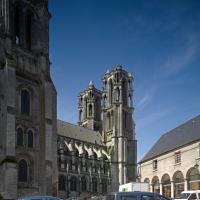
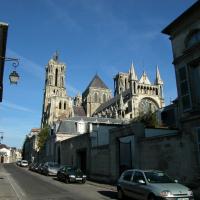
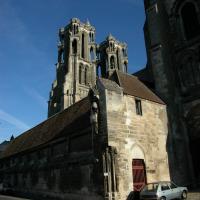
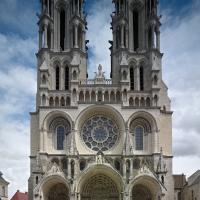
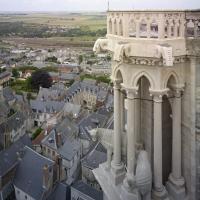
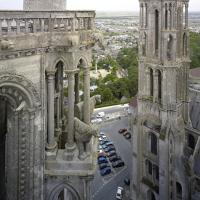

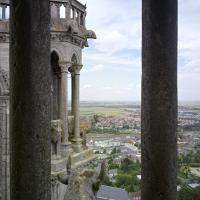
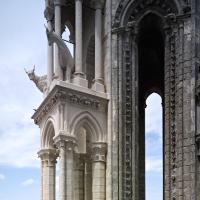
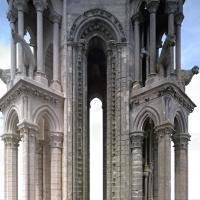

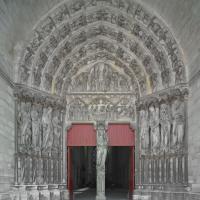
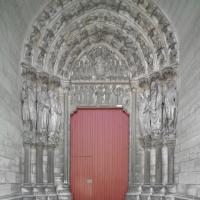
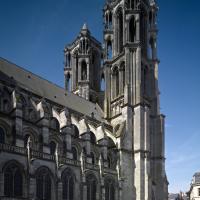
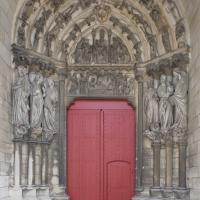
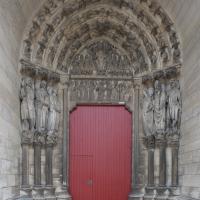

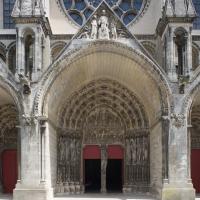
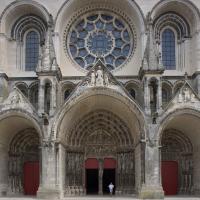
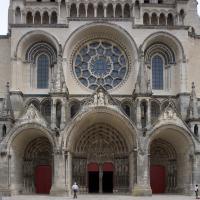
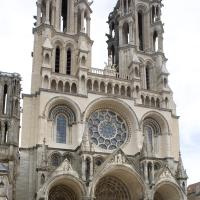
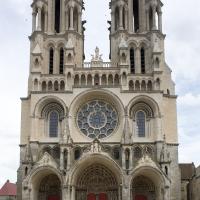
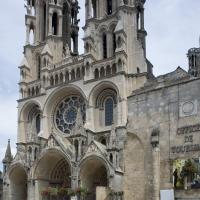
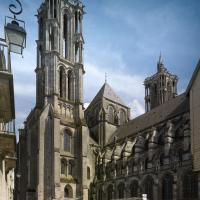
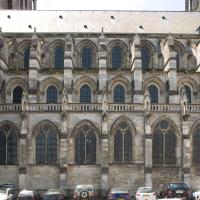
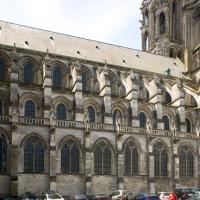

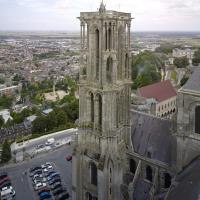
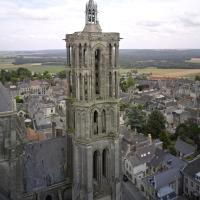
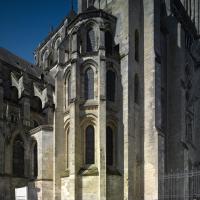

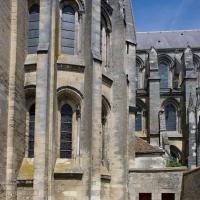
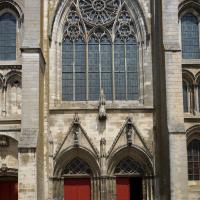
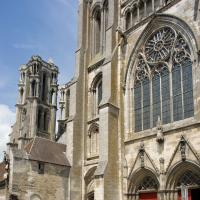
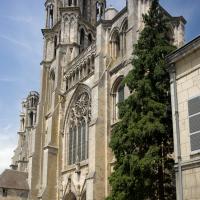
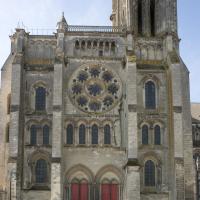
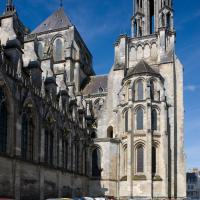
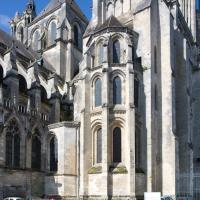
![Cathédrale Notre-Dame de Laon - Exterior, upper transept, north side, gallery window capital [first bay from crossing] Cathédrale Notre-Dame de Laon - Exterior, upper transept, north side, gallery window capital [first bay from crossing]](/sites/default/files/styles/medium_crop/public/media-thumbnails/taxonomy/term/1-hreflangenimage/a/art-atlas/mapping-gothic-hreflangenmapping-gothic/a/1024_00197.jpg?itok=wpBdRiLL)

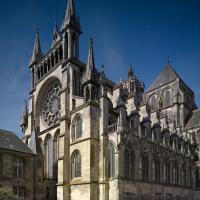
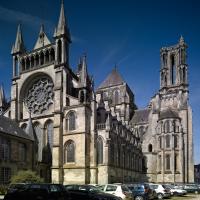


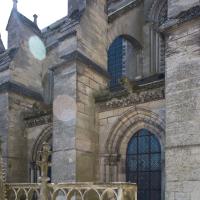
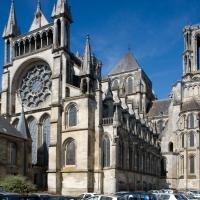
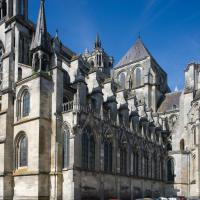
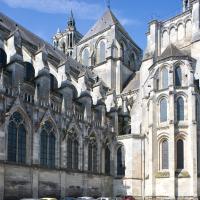
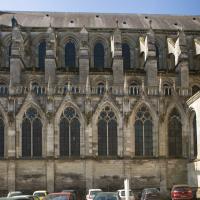
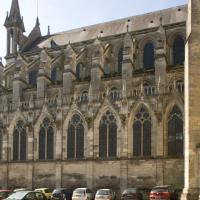
![Cathédrale Notre-Dame de Laon - Exterior, north choir gallery capital [third bay to the east] Cathédrale Notre-Dame de Laon - Exterior, north choir gallery capital [third bay to the east]](/sites/default/files/styles/medium_crop/public/media-thumbnails/taxonomy/term/1-hreflangenimage/a/art-atlas/mapping-gothic-hreflangenmapping-gothic/a/1024_00193.jpg?itok=fvEFK6KM)
![Cathédrale Notre-Dame de Laon - Exterior, north choir gallery capital [third bay to the east] Cathédrale Notre-Dame de Laon - Exterior, north choir gallery capital [third bay to the east]](/sites/default/files/styles/medium_crop/public/media-thumbnails/taxonomy/term/1-hreflangenimage/a/art-atlas/mapping-gothic-hreflangenmapping-gothic/a/1024_00194.jpg?itok=STi9USbu)
![Cathédrale Notre-Dame de Laon - Exterior, north choir gallery capital [second bay to the east] Cathédrale Notre-Dame de Laon - Exterior, north choir gallery capital [second bay to the east]](/sites/default/files/styles/medium_crop/public/media-thumbnails/taxonomy/term/1-hreflangenimage/a/art-atlas/mapping-gothic-hreflangenmapping-gothic/a/1024_00195.jpg?itok=PTPRupxa)
![Cathédrale Notre-Dame de Laon - Exterior, upper chevet, north side, gallery window capital [first bay from crossing] Cathédrale Notre-Dame de Laon - Exterior, upper chevet, north side, gallery window capital [first bay from crossing]](/sites/default/files/styles/medium_crop/public/media-thumbnails/taxonomy/term/1-hreflangenimage/a/art-atlas/mapping-gothic-hreflangenmapping-gothic/a/1024_00196.jpg?itok=4moGmBDL)
![Cathédrale Notre-Dame de Laon - Exterior, upper chevet, north side, gallery window capital [first bay from crossing] Cathédrale Notre-Dame de Laon - Exterior, upper chevet, north side, gallery window capital [first bay from crossing]](/sites/default/files/styles/medium_crop/public/media-thumbnails/taxonomy/term/1-hreflangenimage/a/art-atlas/mapping-gothic-hreflangenmapping-gothic/a/1024_00198.jpg?itok=SDiOnMzm)
![Cathédrale Notre-Dame de Laon - Exterior, upper chevet, north side, gallery window capital [second bay to the east] Cathédrale Notre-Dame de Laon - Exterior, upper chevet, north side, gallery window capital [second bay to the east]](/sites/default/files/styles/medium_crop/public/media-thumbnails/taxonomy/term/1-hreflangenimage/a/art-atlas/mapping-gothic-hreflangenmapping-gothic/a/1024_00199.jpg?itok=VQh2-4dB)
![Cathédrale Notre-Dame de Laon - Exterior, upper chevet, north side, gallery cornice [third buttress (west to east)] Cathédrale Notre-Dame de Laon - Exterior, upper chevet, north side, gallery cornice [third buttress (west to east)]](/sites/default/files/styles/medium_crop/public/media-thumbnails/taxonomy/term/1-hreflangenimage/a/art-atlas/mapping-gothic-hreflangenmapping-gothic/a/1024_00200.jpg?itok=pC2ayt5Z)
![Cathédrale Notre-Dame de Laon - Exterior, upper chevet, north side, gallery cornice [fourth buttress (west to east)] Cathédrale Notre-Dame de Laon - Exterior, upper chevet, north side, gallery cornice [fourth buttress (west to east)]](/sites/default/files/styles/medium_crop/public/media-thumbnails/taxonomy/term/1-hreflangenimage/a/art-atlas/mapping-gothic-hreflangenmapping-gothic/a/1024_00201.jpg?itok=38x6n1fv)
![Cathédrale Notre-Dame de Laon - Exterior, upper chevet, north side, gallery cornice buttress [second buttress (west to east)] Cathédrale Notre-Dame de Laon - Exterior, upper chevet, north side, gallery cornice buttress [second buttress (west to east)]](/sites/default/files/styles/medium_crop/public/media-thumbnails/taxonomy/term/1-hreflangenimage/a/art-atlas/mapping-gothic-hreflangenmapping-gothic/a/1024_00202.jpg?itok=m9UL0go9)
![Cathédrale Notre-Dame de Laon - Exterior, upper chevet, north side, gallery cornice [first buttress (west to east)] Cathédrale Notre-Dame de Laon - Exterior, upper chevet, north side, gallery cornice [first buttress (west to east)]](/sites/default/files/styles/medium_crop/public/media-thumbnails/taxonomy/term/1-hreflangenimage/a/art-atlas/mapping-gothic-hreflangenmapping-gothic/a/1024_00203.jpg?itok=ClqyJy1D)
